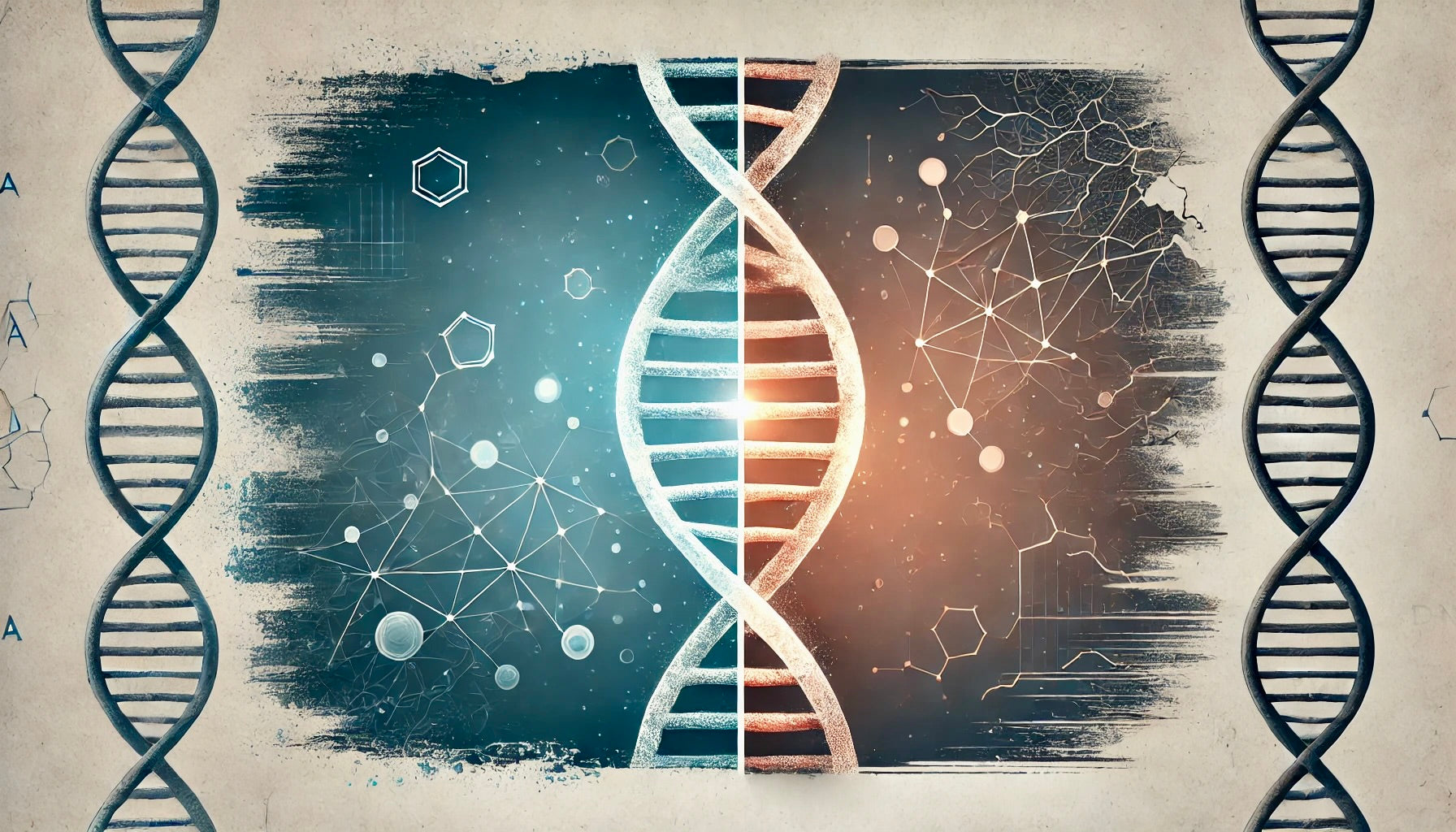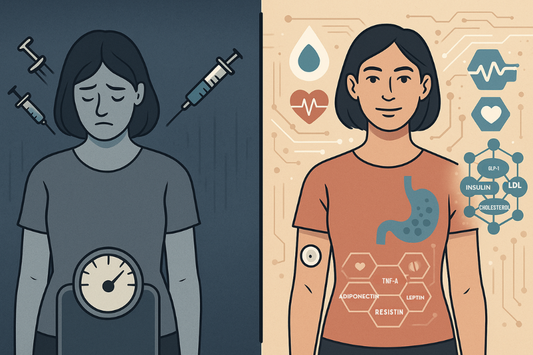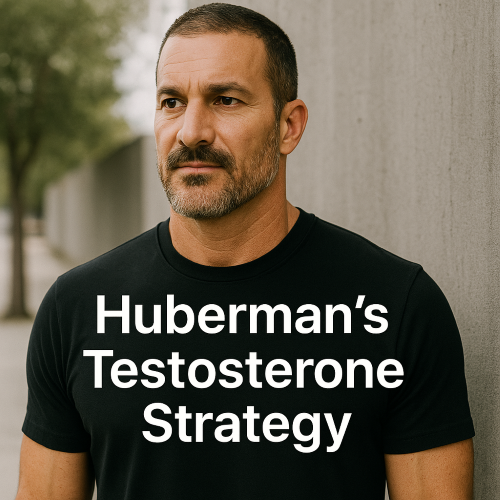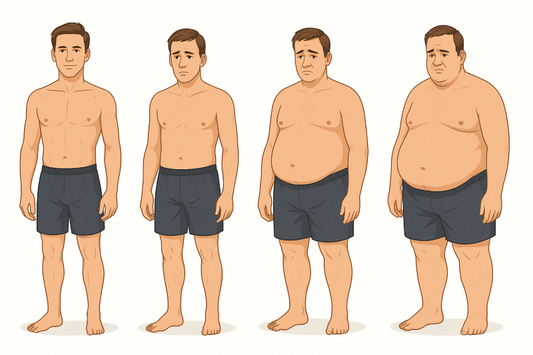We all want to live better and age better. There is compelling evidence that the secret to a longer, healthier life lies deep inside our cells.
Let me explain.

There’s a famous photograph of a 69-year-old truck driver whose face tells a powerful story. After nearly three decades behind the wheel, sun pouring through the driver’s side window, the left side of his face is deeply wrinkled, sagging, and visibly aged. The right side, mostly shielded from the sun, looks 20 years younger.
The difference? UV-induced DNA damage.
Every day, your DNA is attacked by UV radiation, pollution, stress, poor sleep, and even your metabolism. Your body can repair most of this — for a while. But what happens if over time, your DNA repair systems start to slow down or become overwhelmed?
The result? Accumulated damage alters the instructions your cells rely on to function properly and to produce the normal proteins, muscles, hormones or neurotransmitters.
And it’s not just skin. That same accumulation is happening throughout your body — in your brain, muscles, and organs — slowly degrading how you feel, think, and recover.
In fact, research estimates that every cell in your body may suffer 36,000 to 160,000 DNA lesions per day. (1,13) Normally, enzymes like PARP1 and SIRT1 step in to repair the damage — but their effectiveness declines as you age. A key approach to longevity is reversing that slow down. (1,3-6)
A landmark study published in PNAS found that mammals with the highest levels of PARP1 lived the longest. (3)This is not just theory—it’s measurable biology.
This is why centenarians — people who live to 100 and beyond — often have elevated levels of DNA repair enzymes like PARP1 and Ku70. Their cells haven’t escaped damage, but they’ve stayed better equipped to fix it. (4)
So, while the truck driver’s face is a dramatic external example, the same battle is being fought inside your body every single day. And how well you support your DNA repair systems might be the most powerful thing you can do for how well — and how long — you live. (2)
What actually happens when DNA gets damaged?
DNA damage isn’t just an abstract concept. It has real effects on your body’s performance.
Here’s what happens:
Your DNA gets damaged by oxidative stress, inflammation, smoking, stress, toxins, UV, etc. (1-3)
Repair mechanisms try to fix it, but over time they get overwhelmed.(3-6)
Cells start misfiring—they make faulty proteins, lose the ability to divide, or self-destruct. (4-6)
This leads to organ and tissue decline: skin thins, muscles weaken, brain power drops, and hormones fall out of balance.
In practical terms, that means:
Skin ageing
DNA damage reduces the function of fibroblasts—the cells that produce collagen and elastin. This means thinner, less elastic, less resilient skin that heals more slowly, just like the trucker's face. DNA repair pathways influence extracellular matrix production, directly affecting skin integrity. (5)
Muscle wasting
Muscle stem cells (satellite cells) are highly vulnerable to DNA damage. A publication in Science showed that enhancing mitochondrial DNA repair in aged muscle significantly improved regeneration and endurance. (6-7)
Brain fog and dementia
Neurones accumulate oxidative DNA damage over time, particularly in the hippocampus (memory centre) and frontal cortex. This impairs neurotransmitter balance and plasticity—leading to brain fog, memory lapses, and slower cognition.
Hormones & energy drop
DNA damage in endocrine tissues (like the thyroid, ovaries, and adrenals) disrupts hormone production. Damage in the hypothalamus and pituitary—key regulators of the hormonal axis—reduces resilience, energy, and metabolism.
The crucial machinery that may make you age faster - sirtuins and PARPs (3-6, 11-12)
Multiple studies have demonstrated that reducing sirtuins and PARPs dramatically reduces the ability to repair DNA lifespan.
That DNA repair mechanism has been identified and relies on two key enzymes: sirtuins and PARPs. These are your body’s internal repair crews. But they need fuel to work—they are dependent on a critical molecule called NAD+ to power their activity.
PARPs are NAD+ hungry and are the biggest drain on cellular NAD. As damage accumulates they use more and more NAD, thereby depleting other mechanisms like the mitochondria who also need NAD to produce energy.
Here’s the catch and a key insight into why ageing happens: NAD+ levels drop by up to 50% by the time you’re 50.
Without enough NAD+, your cellular repair slows, and DNA damage accumulates.
That’s why restoring NAD+ and supporting sirtuin and PARP activity is a key strategy in slowing the rate of biological ageing.
“Studies of centenarians show that high DNA repair activity correlates with extended lifespan and better health in old age.” (4)
— Chevanne et al., Rejuvenation Research, 2007
What do sirtuins and PARPs actually do?
Together, sirtuins and PARPs form the backbone of your DNA repair system—but without sufficient NAD⁺, they stall, and DNA damage builds up.
Maintaining healthy NAD⁺ levels is therefore central to any serious longevity plan.
Your body is constantly under stress—from toxins, UV light, poor diet, lack of sleep, and even just the act of living and breathing. This stress damages your DNA, which, left unrepaired, accelerates ageing.
Sirtuins and PARPs are two families of enzymes that act to repair this damage many thousands of times per day.
Sirtuins – The regulators (6,10-12)
Sirtuins are a group of proteins (SIRT1–SIRT7) that regulate a wide range of critical cellular functions:
DNA repair: SIRT1 and SIRT6 activate DNA repair pathways, especially in response to double-strand breaks.
Mitochondrial health: SIRT3 and SIRT5 support energy production and protect against oxidative damage.
Inflammation & metabolism: Sirtuins help silence inflammatory genes and optimise fat and glucose metabolism.
Cellular resilience: They help cells survive under stress by managing apoptosis (cell death) and autophagy (cell clean-up).
Sirtuins are NAD⁺-dependent, meaning they can’t function without a constant supply of this crucial molecule. As NAD⁺ drops with age, so does sirtuin activity—which may explain why ageing accelerates after mid-life.
Study highlight: Roichman, A., Elhanati, S., Aon, M.A. et al. Restoration of energy homeostasis by SIRT6 extends healthy lifespan. Nat Commun 12, 3208 (2021).
PARPs – The DNA fixers
PARPs (Poly ADP-ribose polymerases) are a family of enzymes that detect DNA damage and kickstart repair processes.
PARP1 is the most abundant and best studied. It binds to DNA breaks and rapidly signals other repair proteins to the site of damage.
This process uses huge amounts of NAD⁺—making PARPs one of the main cellular consumers of NAD⁺.
This is protective in short bursts. But chronic overactivation (e.g., from ongoing oxidative stress) can drain NAD⁺ and impair mitochondrial function.
Study highlight: Species with higher natural PARP activity (like humans and elephants) tend to live longer.
Centenarians have higher PARP1 and Ku70 levels than younger individuals (Grube & Bürkle, PNAS, 1992). (4)
DNA damage happens in every tissue, but the effect is different
DNA damage in fast-dividing cells like the gut, skin, and immune system can lead to mutations and even cancer.
In slow-dividing cells like neurones and muscle fibres, damage accumulates, leading to dysfunction and degeneration.
That's why age-related issues affect different organs and tissues in different ways.
How to slow DNA damage and increase repair
Although you intuitively know a lot of this, this is the reason that paying attention to your lifestyle makes a difference. Knowledge is power and it's also motivation.
You can’t stop DNA damage entirely—but you can reduce it and importantly as you age make a significant difference and support your repair systems.
IMPORTANT: Sleep. Good sleep. Regular sleep. Deep sleep.
Those in their 50's and above who sleep less than 6 hours have a 30% increased risk of developing dementia compared to those who sleep 7 hours. Regularly sleeping less than 6 hours has an increased risk of death of 12% over 25 hours.
Your DNA repair systems, including sirtuins, are most active during deep sleep. Poor sleep = more damage, less repair.
If you can't sleep, then support it. There are natural and healthy ways to do this; check out the humanpeople sleep page to learn more.
Fast or eat within a time window
Intermittent fasting boosts NAD+ and sirtuin activity, enhancing DNA repair pathways.
Cut the booze, limit alcohol, sugar, and toxins.
These increase oxidative stress, which is the biggest driver of DNA damage.
Movement
Exercise stimulates mitochondrial repair and improves resilience.
The targeted supplementation approach to improve energy and DNA repair
Getting the lifestyle changes into place and reducing the burden on your body is the essential first step. Then, you can optimise by giving your body the raw materials it needs to fight ageing at a cellular level.
These three supplements have the largest body of evidence to support their use. By activating repair mechanisms and fuelling them not only will you improve energy levels in the body and reduce inflammation but your future self will also be very thankful.
1. Liposomal Resveratrol (500mg, 50% Trans-Resveratrol) (10-12)
Why it matters: Activates SIRT1, the most important sirtuin longevity enzyme involved in DNA repair, inflammation regulation, and mitochondrial health.
Why liposomal? It's a real challenge to absorb enough resveratrol as oral resveratrol has notoriously poor bioavailability. Liposomal delivery increases absorption up to 10x and doesn't need to be taken with food.
Recommended use: Take it daily, ideally in the morning, with liposomal delivery. It doesn't matter if you take it with or without food.
2. Liposomal Apigenin (8,9)
Apigenin does a lot of good things in the body and, until recently, was limited by poor bioavailability. Finally, liposomal preparation has solved that, and that is a game changer.
You can read more about apigenin here. However, it not only reduces inflammation, is an aromatase inhibitor, and calms the brain due to its GABA effect. It is also effective at stopping the breakdown of NAD.
Why it matters: Inhibits CD38, the enzyme that depletes your NAD+ stores. By blocking CD38, apigenin helps conserve NAD+, keeping your repair enzymes active.
Recommended use: 50–100mg/day, ideally taken alongside NAD+ precursors like NR.
3. Nicotinamide Riboside (NR) (500mg) or NMN (7)
The best way to boost NAD is to take one of the precursors, NR or NMN. It doesn't matter. They are equally effective and are well absorbed. Unlike apigenin or resveratrol, you don't need to spend more on liposomal as it is well absorbed.
Why it matters: A proven NAD+ precursor that restores levels is my absolute must for health. Clinical studies show improved mitochondrial function and cognitive markers in older adults.
Recommended dose: The effects build over weeks. After a few weeks, maximum NAD levels saturate at doses over 500mg. Starting off with a higher dose and then reducing down makes sense.
NAD booster + : NR plus liposomal apigenin + liposomal resveratrol in a daily sachet
Summary
If you ever hear yourself saying, "I'm just getting old", please stop and consider that phrase.
If you don't feel quite right, then that suggests that something is not functioning properly. Don't be fobbed off by "you're just the worried well". It means something is a bit off. Invest in your health and try to understand the issue. Health is the most valuable thing you have. When you are feeling ok it is easy not to be proactive, it ignore niggles but don't. As a friend told me recently: "The person with health has a thousand problems, but the person who is ill has only one problem".
Ageing is not just about time passing. Multiple systems in your body will all have an impact on ageing. However, DNA health is the base of that pyramid and is critical. Without good DNA health, every other mechanism in the body will be affected. It’s about damage accumulating—especially to your DNA.
By understanding the mechanisms and giving your body the tools it needs to repair itself through targeted lifestyle choices and scientifically supported supplements, I hope this article will help motivate you to maintain your health for as long as possible and allow you to live your best life.
Dr Geoff Mullan
Functional and Longevity Medicine Doctor
Chief Medical Officer humanpeople
This article does not constitute medical advice and is the opinion of the author.
References
1. Freitas AA, de Magalhães JP. A review and appraisal of the DNA damage theory of ageing. Mutat Res. 2011 Jul-Oct;728(1-2):12-22. doi: 10.1016/j.mrrev.2011.05.001. Epub 2011 May 10. PMID: 21600302.
2. Lombard DB, Chua KF, Mostoslavsky R, Franco S, Gostissa M, Alt FW. DNA repair, genome stability, and aging. Cell. 2005 Feb 25;120(4):497-512. doi: 10.1016/j.cell.2005.01.028. PMID: 15734682.
3. Grube K, Bürkle A. Poly(ADP-ribose) polymerase activity in mononuclear leukocytes of 13 mammalian species correlates with species-specific life span. Proc Natl Acad Sci U S A. 1992 Dec 15;89(24):11759-63. doi: 10.1073/pnas.89.24.11759. PMID: 1465394; PMCID: PMC50636.
4. Chevanne M, Calia C, Zampieri M, Cecchinelli B, Caldini R, Monti D, Bucci L, Franceschi C, Caiafa P. Oxidative DNA damage repair and parp 1 and parp 2 expression in Epstein-Barr virus-immortalized B lymphocyte cells from young subjects, old subjects, and centenarians. Rejuvenation Res. 2007 Jun;10(2):191-204. doi: 10.1089/rej.2006.0514. PMID: 17518695.
5. Duthie SJ, Hawdon A. DNA instability (strand breakage, uracil misincorporation, and defective repair) is increased by folic acid depletion in human lymphocytes in vitro. FASEB J. 1998 Nov;12(14):1491-7. PMID: 9806758.
6. Bonkowski, M., Sinclair, D. Slowing ageing by design: the rise of NAD+ and sirtuin-activating compounds. Nat Rev Mol Cell Biol 17, 679–690 (2016).
7. Yoshino J, Baur JA, Imai SI. NAD+ Intermediates: The Biology and Therapeutic Potential of NMN and NR. Cell Metab. 2018 Mar 6;27(3):513-528. doi: 10.1016/j.cmet.2017.11.002. Epub 2017 Dec 14. PMID: 29249689; PMCID: PMC5842119.. Cell Metab, 2011.
8. Kramer DJ, Johnson AA. Apigenin: a natural molecule at the intersection of sleep and aging. Front Nutr. 2024 Feb 27;11:1359176. doi: 10.3389/fnut.2024.1359176. PMID: 38476603; PMCID: PMC10929570.
9. Ogura Y, Kitada M, Xu J, Monno I, Koya D. CD38 inhibition by apigenin ameliorates mitochondrial oxidative stress through restoration of the intracellular NAD+/NADH ratio and Sirt3 activity in renal tubular cells in diabetic rats. Aging (Albany NY). 2020 Jun 7;12(12):11325-11336. doi: 10.18632/aging.103410. Epub 2020 Jun 7. PMID: 32507768; PMCID: PMC7343471.
10 . Rogina B, Tissenbaum HA. SIRT1, resveratrol and aging. Front Genet. 2024 May 9;15:1393181. doi: 10.3389/fgene.2024.1393181. PMID: 38784035; PMCID: PMC11112063.
11. Dai H, Sinclair DA, Ellis JL, Steegborn C. Sirtuin activators and inhibitors: Promises, achievements, and challenges. Pharmacol Ther. 2018 Aug;188:140-154. doi: 10.1016/j.pharmthera.2018.03.004. Epub 2018 Mar 22. PMID: 29577959; PMCID: PMC6342514.
12. Bonkowski MS, Sinclair DA. Slowing ageing by design: the rise of NAD+ and sirtuin-activating compounds. Nat Rev Mol Cell Biol. 2016 Nov;17(11):679-690. doi: 10.1038/nrm.2016.93. Epub 2016 Aug 24. PMID: 27552971; PMCID: PMC5107309.
13. Yousefzadeh M, Henpita C, Vyas R, Soto-Palma C, Robbins P, Niedernhofer L. DNA damage-how and why we age? Elife. 2021 Jan 29;10:e62852. doi: 10.7554/eLife.62852. PMID: 33512317; PMCID: PMC7846274.
14. Khan RI, Nirzhor SSR, Akter R. A Review of the Recent Advances Made with SIRT6 and its Implications on Aging Related Processes, Major Human Diseases, and Possible Therapeutic Targets. Biomolecules. 2018 Jun 29;8(3):44. doi: 10.3390/biom8030044. PMID: 29966233; PMCID: PMC6164879.






